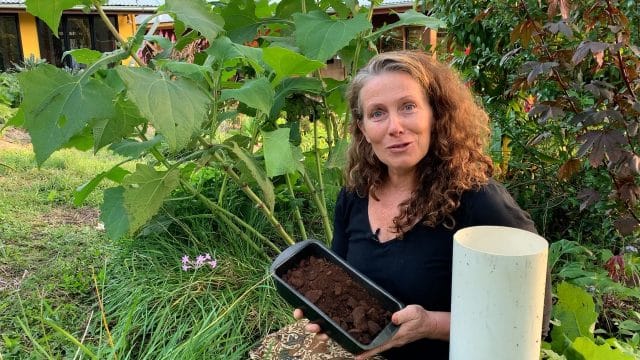Around 10 billion kilograms of coffee a year is grown, roasted and ground to make over 2 billion cups of coffee every day around the world. That’s a lot of coffee, and just as much coffee grounds! What happens to it all?
It’s difficult to find out where it all goes, but a 2015 study from Sydney cafes shows that over 90% of of the used grounds end up in landfills where they eventually decompose and produce methane – a greenhouse gas twenty times more potent than carbon dioxide.
Let’s harvest this abundance.
Compost it.
Waste = Food
In the video below I will teach you a few ways to use used coffee grounds in your garden. Check it out!
Coffee is a nutrient-rich addition for your garden soil – particularly when it’s been composted, and it is not acidic.
I often grab several bags of used coffee from cafes when I go to town. A couple of places have it already bagged up for you to take. I also collect all my own coffee grounds, and tea leaves, at home.
Community composting systems could be hugely successful for urban market gardens and city farms. Oyster mushrooms are also successfully grown on used coffee grounds – urban mushroom farm, then use it again as mushroom compost.
I’ve seen a lot contradictory information on the internet about using coffee in the garden. This is what I do with this abundant resource.
COMPOST COFFEE GROUNDS
I add coffee grounds regularly into my compost bin and compost bays – they could also be added to a compost tumbler.
Coffee grounds are like a slow release fertiliser but they need composting first for the plants to really make use of them. Coffee grounds are high in nitrogen – similar to grass clippings. This makes them a ‘green’ ingredient in your compost bin to balance high carbon ingredients.
FEED WORMS COFFEE GROUNDS
My worms love used coffee grounds. Coffee grounds can be added to worm farms at a rate of up to 25% of their food. I find that worms prefer it spread around rather than in big clumps. I also often pour a good handful of coffee grounds into my worm towers scattered through my garden every week or two.
 |
| I add coffee grounds regularly into my worm farm, along with paper, fruit, veg and other biodegradable items. The funnel is Hugh’s ingenious idea for harvesting worms – check out our clip about this on https://youtu.be/SU9ezKWec0M |
PLANT CARROTS WITH COFFEE
I plant carrots with coffee. First I mix the carrot or other small seeds with coffee grounds, then sprinkle out over the composted soil, cover with a little more soil and water in. The coffee helps with the even sowing of the very small seeds and adds some soil amendments at the same time.
MYTH: Used coffee grounds are acidic.
Contrary to popular belief used coffee grounds are not acidic – they have an almost neutral pH. Surprising isn’t it. Yes, fresh coffee grounds are acidic. The coffee we drink is acidic, BUT used coffee grounds are not. The water leaches out the acidity leaving the grounds a neutral 6.5 to 6.8 pH.
COLLECT USED COFFEE GROUNDS
With millions of tonnes of used coffee grounds being produced and thrown away daily, finding this resource should not be too difficult:
- local cafe – like I mentioned above, many cafes have some ready to give away at the counter. But if not, most cafe owners are happy to put some aside for you if you ask.
I think it’s best to avoid the pod machines. The grounds are difficult to extract and just too much plastic. There are also many more reasons to start (or keep) using this waste resource in your garden and on your body – but more about that another time.
What is permaculture?
To learn more about permaculture check out my 4 part permaculture series and take a look at Our Permaculture Life youtube channel where I have uploaded over 100 films I have made in my permaculture garden and in conversation with others. Dive deeper into this blog too and you will find over 400 permaculture articles.
Now is such a great time to learn more about permaculture and consider making permaculture your way of life and livelihood too. To help with this, I offer two online permaculture courses:
I also encourage you to support free permaculture education programs for women and youth in the global south through our registered permaculture charity, the Ethos Foundation.





i throw mine into my tea bucket under the table, then it goes straight out under a tree, who ever needs it, also my blueberry loves coffee grounds too.
once in a while, like now when it's really wet, then the bucket gets tossed onto the compost pile
great post
thanx for sharing
I find value in every single one of your blog posts! Just wanted to say that Monica's in Maleny offers bags of coffee grinds for $2 for charity and Mayfield Patisserie and Chocolates in Montville offers free bags of coffee grinds. 🙂
Thanks Morag, very useful.
Thanks for this information. I have no trouble getting all the free coffee grounds I need here in Oakland, CA. I have a couple of large bags of it that's been just sitting around all season. Does it compost by itself?
I am starting an online organic/FreeTrade coffee company and would like to use some of this information or link to your site on my blog.
thanks for that tip. my blueberries could use a boost.